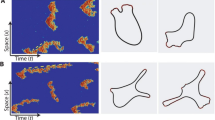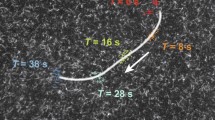Abstract
Correlated random walks (CRW) have been explored in many settings, most notably in the motion of individuals in a swarm or flock. But some subcellular systems such as growth or disassembly of bio-polymers can also be described with similar models and understood using related mathematical methods. Here we consider two examples of growing cytoskeletal elements, actin and microtubules. We use CRW or generalized CRW-like PDEs to model their spatial distributions. In each case, the linear models can be reduced to a Telegrapher’s equation. A combination of explicit solutions (in one case) and numerical solutions (in the other) demonstrates that the approach to steady state can be accompanied by (decaying) waves.





Similar content being viewed by others
References
Adler Y, Givli S (2013) Closing the loop: lamellipodia dynamics from the perspective of front propagation. Phys Rev E 88(4):042708
Allard J, Mogilner A (2013) Traveling waves in actin dynamics and cell motility. Curr Opin Cell Biol 25(1):107–115
Bretschneider T, Anderson K, Ecke M, Müller-Taubenberger A, Schroth-Diez B, Ishikawa-Ankerhold HC, Gerisch G (2009) The three-dimensional dynamics of actin waves, a model of cytoskeletal self-organization. Biophys J 96(7):2888–2900
Carlsson AE (2010) Dendritic actin filament nucleation causes traveling waves and patches. Phys Rev Lett 104(22):228102
Dogterom AM (1994) Aspects physiques de l’assemblage des microtubules et du fuseau mitotique; phd thesis. Ph.D. thesis, Universite de Paris, Centre D’Orsay
Dogterom M, Leibler S (1993) Physical aspects of the growth and regulation of microtubule structures. Phys Rev Lett 70(9):1347
Dogterom M, Maggs A, Leibler S (1995) Diffusion and formation of microtubule asters: physical processes versus biochemical regulation. Proc Natl Acad Sci 92(15):6683–6688
Dunbar SR, Othmer HG (1986) On a nonlinear hyperbolic equation describing transmission lines, cell movement, and branching random walks. In: Othmer HG (ed) Nonlinear oscillations in biology and chemistry. Lecture notes in biomathematics, vol 66. Springer, Berlin, Heidelberg, pp 274–289
Eftimie R (2012) Hyperbolic and kinetic models for self-organized biological aggregations and movement: a brief review. J Math Biol 65(1):35–75
Gou J, Edelstein-Keshet L, Allard J (2014) Mathematical model with spatially uniform regulation explains long-range bidirectional transport of early endosomes in fungal hyphae. Mol Biol Cell 25(16):2408–2415
Grimm H, Verkhovsky A, Mogilner A, Meister JJ (2003) Analysis of actin dynamics at the leading edge of crawling cells: implications for the shape of keratocyte lamellipodia. Eur Biophys J 32(6):563–577
Hadeler K (1996) Reaction telegraph equations and random walk systems. Stoch Spat Struct Dyn Syst 45:133
Hadeler KP (1999) Reaction transport systems in biological modelling. In: Capasso V (ed) Mathematics inspired by biology. Lecture notes in mathematics, vol 1714. Springer, Berlin, Heidelberg, pp 95–150
Hadeler KP (2000) Reaction transport equations in biological modeling. Math Comput Model 31(4–5):75–81
Hadeler KP (2017) Topics in mathematical biology. Lecture notes on mathematical modelling in the life sciences. Springer, Berlin
Hillen T (1996) A turing model with correlated random walk. J Math Biol 35(1):49–72
Hillen T, Leonard IE, Van Roessel H (2014) Partial differential equations: theory and completely solved problems. Wiley, Hoboken
Holmes WR, Carlsson AE, Edelstein-Keshet L (2012) Regimes of wave type patterning driven by refractory actin feedback: transition from static polarization to dynamic wave behaviour. Phys Biol 9(4):046005
Kac M (1974) A stochastic model related to the telegrapher’s equation. Rocky Mt J Math 4(3):497–509
Keren K, Pincus Z, Allen GM, Barnhart EL, Marriott G, Mogilner A, Theriot JA (2008) Mechanism of shape determination in motile cells. Nature 453(7194):475
Mata MA, Dutot M, Edelstein-Keshet L, Holmes WR (2013) A model for intracellular actin waves explored by nonlinear local perturbation analysis. J Theor Biol 334:149–161
Okubo A, Levin SA (2001) Diffusion and ecological problems: modern perspectives, vol 14. Springer, Berlin
Othmer HG, Hillen T (2000) The diffusion limit of transport equations derived from velocity-jump processes. SIAM J Appl Math 61(3):751–775
Othmer HG, Dunbar SR, Alt W (1988) Models of dispersal in biological systems. J Math Biol 26(3):263–298
Rohatgi R, Ma L, Miki H, Lopez M, Kirchhausen T, Takenawa T, Kirschner MW (1999) The interaction between n-wasp and the arp2/3 complex links cdc42-dependent signals to actin assembly. Cell 97(2):221–231
Rubinstein B, Jacobson K, Mogilner A (2005) Multiscale two-dimensional modeling of a motile simple-shaped cell. Multiscale Model Simul 3(2):413–439
Svitkina TM, Borisy GG (1999) Arp2/3 complex and actin depolymerizing factor/cofilin in dendritic organization and treadmilling of actin filament array in lamellipodia. J Cell Biol 145(5):1009–1026
Weinberger H (1995) A first course in partial differential equations: with complex variables and transform methods (Dover books on mathematics). Dover Publications, Mineola
Weiner OD, Marganski WA, Wu LF, Altschuler SJ, Kirschner MW (2007) An actin-based wave generator organizes cell motility. PLoS Biol 5(9):e221
Acknowledgements
AB is supported by an NSERC post-doctoral fellowship; LEK is supported by an NSERC Discovery grant; We are grateful to the Pacific Institute for Mathematical Sciences for providing space and resources for AB’s postdoctoral research.
Author information
Authors and Affiliations
Corresponding author
Additional information
Publisher's Note
Springer Nature remains neutral with regard to jurisdictional claims in published maps and institutional affiliations.
Rights and permissions
About this article
Cite this article
Buttenschön, A., Edelstein-Keshet, L. Correlated random walks inside a cell: actin branching and microtubule dynamics. J. Math. Biol. 79, 1953–1972 (2019). https://doi.org/10.1007/s00285-019-01416-6
Received:
Revised:
Published:
Issue Date:
DOI: https://doi.org/10.1007/s00285-019-01416-6
Keywords
- Actin branching
- Microtubule growth and catastrophe
- Spatiotemporal distribution
- Actin waves
- Correlated random walk
- Telegrapher equation




